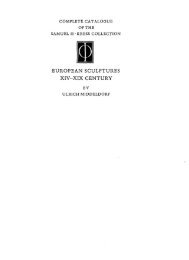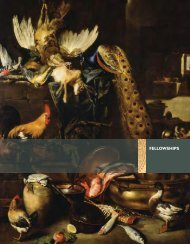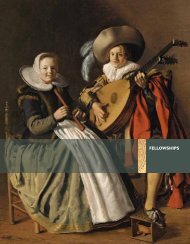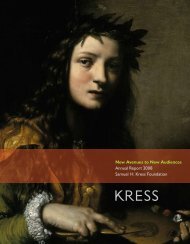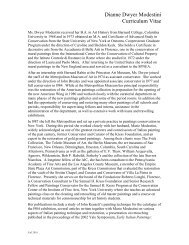The Campus Art Museum - Samuel H. Kress Foundation
The Campus Art Museum - Samuel H. Kress Foundation
The Campus Art Museum - Samuel H. Kress Foundation
Create successful ePaper yourself
Turn your PDF publications into a flip-book with our unique Google optimized e-Paper software.
<strong>The</strong> <strong>Campus</strong> <strong>Art</strong> <strong>Museum</strong>: A Qualitative<br />
Study: Preface<br />
At least 700 academic institutions in the United States have an art museum or<br />
exhibition gallery (Russell & Spencer 2000, 6). We know attendance at American<br />
art museums in general has risen nearly four-fold in the last fifty years (Cuno<br />
2004, 17), but we know less about the experiences within the academic art museum.<br />
How do students, faculty, and the public make use of campus art museums and<br />
how do the museums enrich personal and academic lives? What do academic art<br />
museums and galleries contribute to their parent organizations and communities?<br />
What institutional factors help them thrive? <strong>The</strong>se questions, among others, were<br />
discussed at national meetings attended by staff of the <strong>Samuel</strong> H. <strong>Kress</strong> <strong>Foundation</strong>.<br />
<strong>The</strong>y proposed that the <strong>Kress</strong> <strong>Foundation</strong> sponsor a study to look at campus<br />
art museums. I was subsequently commissioned to undertake a year-long study<br />
beginning in the fall of 2010. 1<br />
Research Questions<br />
<strong>The</strong> study could not address everything that can be associated with campus<br />
art museums. It does not, for example, focus on the development and use of<br />
exhibitions, care of collections, use of technology, strategic planning for the future,<br />
or why some students and faculty do not use the museum. Rather, we sought to<br />
describe the overall impact of the exemplary campus art museum on the people<br />
who make use of it. 2 We settled on four research questions:<br />
1. In what ways are exemplary campus art museums integrated into the academic<br />
lives of students and faculty?<br />
2. How do students, faculty, and the public interact with campus art museums<br />
beyond the academic curriculum?<br />
3. What institutional cultures and structures support campus art museums and<br />
what major challenges stretch them?<br />
4. How have works of art distributed through the Great <strong>Kress</strong> Giveaway fifty years<br />
ago been used and what difference, if any, have the gifts made for the museums,<br />
students, faculty, and communities where they were bestowed?<br />
Methods<br />
<strong>The</strong> “exemplary” campus art museum became the focus of the study in order<br />
to learn from museums that perceive themselves as models for others. <strong>The</strong><br />
1. Corrine Glesne, a qualitative researcher and educational anthropologist, taught at the University of Vermont for<br />
seventeen years and is author of the text Becoming Qualitative Researchers.<br />
2. When “we” is used in this report it refers to my discussions with staff at the <strong>Kress</strong> <strong>Foundation</strong>. <strong>The</strong> <strong>Kress</strong> <strong>Foundation</strong><br />
played an important role in setting up the study. Responsibility for data collection and interpretation resides with me.<br />
Any errors, therefore, are my own.<br />
<strong>The</strong> <strong>Campus</strong> <strong>Art</strong> <strong>Museum</strong>: A Qualitative Study: Preface<br />
4



